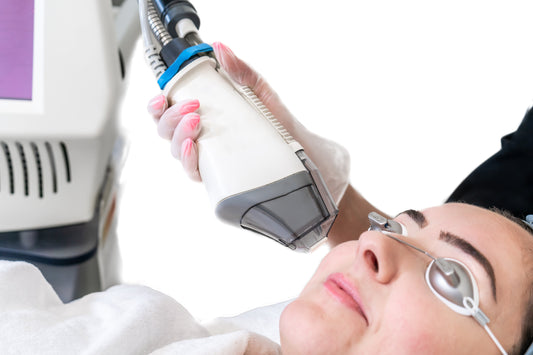Skin pigmentation simply refers to the color of a person’s skin, which is determined by the distribution of a pigment called melanin. Though our genes play a crucial role in our pigmentation, unwanted dark spots and patches can emerge due to hormonal changes, skin damage, and sun exposure.
Read on to learn more about the causes of skin pigmentation, prevention and lifestyle tips to consider, and the best over-the-counter products to use.
Understanding Skin Pigmentation
Melanin, or skin pigment, is produced by cells called melanocytes, and its primary function is to protect the skin from the harmful effects of the sun while giving our skin its unique shade of color. Melanin is also responsible for the color in our hair and eyes.
According to the Cleveland Clinic, most humans have the same number of melanocytes.1 However, the amount of melanin these melanocytes produce varies. Higher melanin production generally results in darker shades of eyes, hair, and skin.
Causes of Skin Pigmentation
Melanin levels are influenced by both one's race and the extent of sunlight exposure. When you’re out in the sun, your body stimulates the production of melanin with the help of an enzyme called tyrosinase as a protective response against harmful UV rays. By absorbing solar heat, this melanin also helps to regulate body temperature.2
Other factors that contribute to changes in skin pigmentation include hormonal fluctuations, certain medications, and autoimmune disorders.
Types of Skin Pigmentation
There are two main types of skin pigmentation, each accompanied by its own triggers. Hyperpigmentation, which refers to dark spots or patches on the skin, can be caused by excess sun exposure, hormonal fluctuations, and certain medications. Hypopigmentation, which refers to lightening of the skin, may be caused by injuries, infections, or autoimmune disorders like vitiligo.
Hyperpigmentation
Hyperpigmentation occurs when there is an excess production of melanin, leading to dark spots or patches on the skin.
Causes of hyperpigmentation include:
- Sun exposure
- Injuries like acne scars or burns
- Hormonal fluctuations, which lead to melasma (sometimes called the “mask of pregnancy”)
- Medications, including NSAIDs and contraceptives
- Addison’s disease, an adrenal disorder
Hypopigmentation
Hypopigmentation occurs when there is a reduction in melanin production, leading to white spots or patches on the skin.
Causes of hypopigmentation include:
- Genetic disorders like albinism, in which the body produces little or no melanin
- Autoimmune disorders like vitiligo, in which melanocytes become damaged
- Skin injuries like healed blisters or burns
- Fungal infections like tinea versicolor, in which the fungus disrupts the normal pigmentation of the skin
Prevention and Lifestyle Tips
One of the most important things you should do whether you’re dealing with unwanted skin pigmentation or not is to practice sun-safe habits. Consistently wearing a broad-spectrum sunscreen with an SPF of 30 or higher (50+ preferred) doesn’t just protect you from hyperpigmentation, but it also lowers your risk of skin cancer, and slows down signs of aging. In addition to wearing sunscreen, here are some of the most important steps to preventing unwanted skin pigmentation:
- Avoid direct sunlight and wear protective layers outside (a hat, sunglasses, etc.)
- Try to limit touching your face and resist the urge to pick at blemishes or insect bites
- Ask your doctor for alternative medications if you think they’re contributing to skin pigmentation
- Regularly exfoliate and moisturize skin
- Avoid skin bleaching products
Best Over-the-Counter Products for Skin Pigmentation
Foundation Skincare offers dermatologist-formulated topical products and supplements that help to reduce and prevent unwanted skin pigmentation. Some of the top products to add to your regimen include:
- Azelaic Acid 14% Cream: A natural byproduct of yeast, azelaic acid helps fade dark spots by inhibiting an enzyme called tyrosinase, which is strongly associated with hyperpigmentation.3 Azelaic acid also has powerful anti-inflammatory properties, which can be helpful in reducing hyperpigmentation related to skin irritation or acne. This product contains a 14% concentration of azelaic acid, which is the highest available without a prescription.
- Niacinamide Lotion 10%: Like azelaic acid, niacinamide has anti-inflammatory properties, which helps to brighten skin. The B vitamin is also known to fade dark spots by suppressing melanin formation4 and has also been shown to protect against oxidative stress and cell damage.5
- Vitamin C Lotion 20%: A potent antioxidant, vitamin C also inhibits the enzyme tyrosinase to suppress melanin production and fade dark spots.6 Along with its brightening effects, vitamin C also stimulates collagen production, which can minimize the appearance of lines and wrinkles caused by sun damage.
- Night Renewal Cream: The Night Renewal Cream visibly reduces dark spots and signs of aging through the power of retinoids. Like azelaic acid and Vitamin C, retinoids also inhibit tyrosinase to reduce melanin formation, while also impacting cell proliferation and inflammation.7
- Pigmentation Defense: This daily supplement helps to improve skin discoloration and pigmentary disorders through a custom blend of antioxidants, vitamins, and herbs. Ingredients like ginkgo biloba, ascorbic acid, and vitamin E help balance melanin production while supporting skin cells and repairing skin tissues.
- Spectrum: Another daily supplement, Spectrum combines plant-based antioxidants like Polypodium Leucotomos (PL) Extract and key vitamins like nicotinamide to fade hyperpigmentation and promote overall skin health. The supplement also protects against environmental stressors and supports skin renewal.
Professional Treatments
For even more support, some people seek professional treatments to help reduce unwanted skin pigmentation. These include:
- Chemical peels: This treatment helps to remove the top layers of the skin to encourage cellular turnover.
- Laser treatments: Like chemical peels, laser treatments also help to remove top layers of the skin using light beams in lieu of chemicals.
- Light therapy: Ideal for those with fair skin, light therapy is a type of laser treatment that can fade flat dark patches while stimulating collagen growth. It can also help reduce the appearance of wrinkles or enlarged pores.
- Microdermabrasion: During this treatment, a drill-like tool is swiped across the skin to gently remove the top layers of skin and any superficial spots or scars.
When to Consult with a Dermatologist
If your unwanted skin pigmentation is causing distress and not responding to other treatments, it’s wise to consult with a board-certified dermatologist. They can help you figure out what’s causing the pigmentation and guide you in the right direction of prescription products, if needed.
Dealing with unwanted skin pigmentation can be frustrating, but armed with the right knowledge and products, you can achieve your skincare goals. Explore more tips and resources in the FS Journal and explore the full Foundation Skincare collection.
References:
-
https://my.clevelandclinic.org/health/body/22615-melanin
-
https://www.ncbi.nlm.nih.gov/pmc/articles/PMC10304091/
-
https://pubmed.ncbi.nlm.nih.gov/2114832/
-
https://pubmed.ncbi.nlm.nih.gov/12100180/
-
https://www.ncbi.nlm.nih.gov/pmc/articles/PMC6824628/
-
https://www.ncbi.nlm.nih.gov/pmc/articles/PMC7802860/
-
https://onlinelibrary.wiley.com/doi/full/10.1111/pcmr.12986




